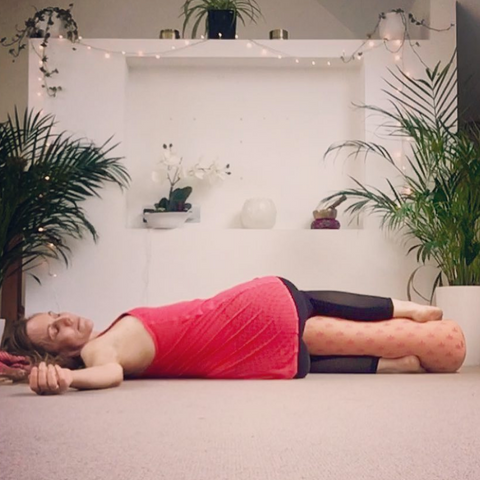Dosha Guide: Pitta
- Rachael Moore

- Dec 28, 2019
- 3 min read
Updated: Dec 29, 2019
If your dosha is predominately Pitta, this article will help you understand how to restore balance to an excess of Pitta-energy with yoga, essential oils, pranayama and other lifestyle tips.

Pitta types are associated with the fire element and to a lesser degree, water. Pitta literally translates to ‘that which cooks' and is responsible for transformation in the body (think metabolism and digestion).
Looking at the nature of fire, it's easy to see that Pitta characteristics will be hot, light, intense, and fluid. Oil is also a major characteristic of pitta, not because fire is oily, but because oils burn intensely in fire.
Characteristics of Pitta
Those with a predominantly Pitta constitution, can quite literally feel the heat more than others and, as such, can be susceptible to heat-related imbalances (eg. prickly heat, heart burn, heat rash) and may perspire easily and heavily.
The fire in their constitutions mean that Pitta types tend to display ‘colour’ in their bodies presenting as red hair, freckles, becoming red and flushed with exercise and when feeling warm.
Pitta types are passionate, driven, organised, efficient, possess sharp memory, and have a keen eye for detail. They're concise and articulate and make good communicators.
A strong appetite and metabolism means energy levels are sustained and sleep, although light to moderate, is usually undisturbed.
An athletic build with average and steady weight, good digestion and easy elimination. In Pitta women, menstruation can be both heavy and long-lasting.
Pitta out of balance
When the natural state and qualities of Pitta become increased with too much heat and sharpness, they can easily give rise to a number of physical and emotional markers including:
feelings of irritation
critical behaviour towards the self and other
impatience
perfectionism
sharp, cutting comments
depletion and 'burnout', feeling trapped by responsibilities
red, angry, inflamed skin
joint discomfort
acid reflux
loose stools
excess sweating
feeling uncomfortably hot
Restoring balance to Pitta
To restore harmony to an excess of Pitta energy, the aim is to focus on activities, foods, interactions, and experiences that are cooling, moderate and offer an element of surrender.
Stay cool by avoiding hot foods, fast-paced chaotic environments and stressful situations
Enjoy a diet that consists mainly of whole, freshly cooked foods and raw foods laced with cooling herbs such as coriander and fennel cooked or dressed with olive, sunflower and/or coconut oils
Focus on tastes that are naturally sweet, bitter and astringent
Keep yourself well hydrated with room temperature water
Eat regular meals
Avoid caffeine and alcohol - it can increase levels of aggression
Take time to be near water - swimming, walks by a lake, cool showers, or regular baths that aren't too hot and feature a few drops of calming essential oils in a base of sunflower or coconut oil
Stay away from spicy, salty, sour, and fried food including chilli, pepper, garlic, onions, nightshades (eg. aubergine and tomatoes), red meat, shellfish, and vinegary foods
Take proper breaks from work
Try to look for the good in the people and situations around you
Practice gratitude daily
Focus on non-competitive activities such as meditation, restorative yoga or yoga nidra
Don't spend too much time sunbathing
Take a few hours away from your phone or laptop
Make sure your daily routine carves out time for both work and play, time to let go, play, be creative and silly - these things will help balance the fire in your persona
If you're considering a holiday break in the summer, avoid very hot destinations and choose somewhere with a moderate climate
Be careful of imbalances in Summer, which can be a vulnerable time as the weather tends to be hot which can aggravate Pitta
Yoga for Pitta
Pitta types are more naturally drawn to a physically demanding and challenging yoga practice that, if not practiced mindfully, can easily overheat the body and mind, and become very depleting.
move towards a cooling practice like yoga nidra, restorative yoga, and yin yoga
practice in a cool, softly-lit environment as it begin to quell the flames and excess heat
keep your drishti (gaze) downwards to encourage cooling
focus on the abdominal area with prone backbends (eg. cobra, locust and sphinx), side bends (eg. triangle, side angle) and twists (eg. half lord of the fishes)
balance excess heat with moon salutations
encourage introspection and cooling with seated, supported forward folds to calm body and mind although don't force or hold too long as they stimulate the abdominal organs, which causes more heat
incorporate pranayama that is cooling - sheetali (cooling breath), sheetkari (hissing breath), and chandra behdha (left nostril breathing)
^ This brief sequence aims to cool the fiery nature of Pitta through balancing pranayama and forward folds which are known to have a calming and balancing effect on the nervous system
Essential oils for Pitta
Using essential oils that have a cooling, sweet and calming effect on body and mind can be a wonderful way to dampen the flames and the irritability of aggravated Pitta.
Add a few drops into your bath (Pittas thrive when submerged in water) or give yourself a soothing self-massage (known in Ayuerveda as abhyanga).
Try oils or blends containing:
peppermint
chamomile
geranium
fennel
lavender









Comments